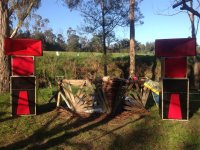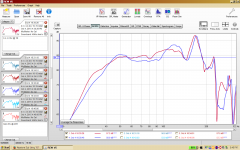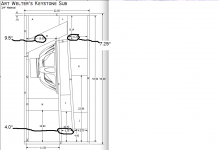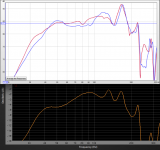I see it's entitled "nearfield". Was that measurement taken @1M or closer?
We took so many but from memory this was at about 50cm from the mouth.
We took so many but from memory this was at about 50cm from the mouth.
Ok, a fairly close-miked measurement
So managed to get the whole system out for a test run on the weekend, stupidly I forgot my microphone so couldn't do any measurements which was one of the main purposes of this test run 
This weekend I have a 3 day outdoor party so will do some measuring before starting.
The sound from the system was breathtaking, the dynamics, spatial clarity (depth and breadth) and tonality just blew my mind and left me very very very happy. It actually matched or bettered any outdoor system I've heard including NEXO and Funktion 1's
The Keystones performed flawlessly and produced massive, and I mean massive!! amounts of bass, I actually set their gain at half because there was so much, relatively. I didn't actually run the system at full capacity as it was way to much, I'm sure onceI get 300 people on the dance floor I'll need that extra bass and output.I can't wait to try a configuration with the 2 Keystones in coupled in the centre.
Anyway, thanks to Art for an amazing design and everyone in this community for sharing their experiences.
This weekend I have a 3 day outdoor party so will do some measuring before starting.
The sound from the system was breathtaking, the dynamics, spatial clarity (depth and breadth) and tonality just blew my mind and left me very very very happy. It actually matched or bettered any outdoor system I've heard including NEXO and Funktion 1's
The Keystones performed flawlessly and produced massive, and I mean massive!! amounts of bass, I actually set their gain at half because there was so much, relatively. I didn't actually run the system at full capacity as it was way to much, I'm sure onceI get 300 people on the dance floor I'll need that extra bass and output.I can't wait to try a configuration with the 2 Keystones in coupled in the centre.
Anyway, thanks to Art for an amazing design and everyone in this community for sharing their experiences.
Attachments
Finally got around to picking up a B&C 18TBW100-8 to compare it with the Peavey Low Riders that I stuck into my Keystones. 2.8volts @1M
I take it the B&C is the red trace?
Finally got around to picking up a B&C 18TBW100-8 to compare it with the Peavey Low Riders that I stuck into my Keystones. 2.8volts @1M
B&C is the red trace.
Have any info on those synergies you're using? I'm starting to draft some plans for building my own and I'm interested in seeing what other people have done.
I didn't build the synergies, Paul Spencer from Red Spade Audio did
Red Spade Audio: S2 prototype - construction
They are amazing matched with the mids and Keystones, I highly recommend the build.
Definite improvement in the LF, but I suspect your mic may be rolling off down there too.Finally got around to picking up a B&C 18TBW100-8 to compare it with the Peavey Low Riders that I stuck into my Keystones. 2.8volts @1M
The sim results in the OP use the same size box for the 18" and the 21".For doing a 21" version would you usually scale up the width to keep at decent compression ratio?
I changed the depth of mine in order to keep the width.
As far as I know, you may be the first to try a 21" in the Keystone, so there is no "usual".
Art
Definite improvement in the LF, but I suspect your mic may be rolling off down there too.
I am at a loss to find out where the rolloff is coming from. New Dayton mic. Could the construction be it? I built mine before all the dims were clear.
Attachments
When new the test mic that came with my Terrasonde Audio Toolbox turned out to be -10 dB at 20 Hz, -6 dB at 35 HzI am at a loss to find out where the rolloff is coming from. New Dayton mic. Could the construction be it? I built mine before all the dims were clear.
I don't think the dimensional changes would result in as much variance in the LF response as your measurements show, but without confirming the response of your mic, that is just speculation.
I extended the depth to 80 cm, giving less compression & a nice sim, plays very nice, deep, loud & massiveThe sim results in the OP use the same size box for the 18" and the 21".
As far as I know, you may be the first to try a 21" in the Keystone, so there is no "usual".
Art
Starting build 2 now, then I can start some A/B experiments with cone correction & different front plate
When new the test mic that came with my Terrasonde Audio Toolbox turned out to be -10 dB at 20 Hz, -6 dB at 35 Hz.
I don't think the dimensional changes would result in as much variance in the LF response as your measurements show, but without confirming the response of your mic, that is just speculation.
I don't think it's the mic. The Dayton mic came with a cal file plus I have two older Peavey measurement mics. All three mics are measuring virtually the same WRT the roll off I am seeing. If they were deficient I wouldn't expect them to be so in the same way?
So that would seem to leave:
1 - the preamp - MAudio USB Pre
2 - the software - REW and HOLMImpulse
3 - cab construction
4 - cab materials
5 - error in measuring technique
6 - unrevised dimensions build - used dims from sketch
I think I can rule out cab construction. All four cabs measure the same and impedance sweeps are virtually the same. If I had loose panels or air leaks I would expect them to show differences between cabs?
I don't think it is materials - but maybe. I used a premium oak veneer plywood from HD and it looks to have few voids and is fairly rigid.
Does anyone else have any traces of a Keystone with the 18TBW100 ?
It would seem odd to have three mics all read the same and not be good, and since all the cabs measure the same, build quality must be good.I don't think it's the mic. The Dayton mic came with a cal file plus I have two older Peavey measurement mics. All three mics are measuring virtually the same WRT the roll off I am seeing. If they were deficient I wouldn't expect them to be so in the same way?
I think I can rule out cab construction. All four cabs measure the same and impedance sweeps are virtually the same. If I had loose panels or air leaks I would expect them to show differences between cabs?
The differences then are likely due to the speaker and cabinet interior measurements.
After changing my chart to the same scale as yours, reviewing your tests with the Peavey Low Rider18 (Blue) and the B&C18TBW100(red) compared to mine with the BC 18SW115-4(Orange) it looks like your BC Keystone is actually smoother from 35 Hz to 150Hz, with a lower corner frequency.
My cabinet shows about a 6 dB variance from 40 Hz to 90 Hz, yours is only about 5 dB, and does not roll off quite as steep below 40 Hz.
The sims show the 18TBW100 is slightly more sensitive than the 18SW115, my bet would be that the two cabinets are about the same sensitivity at 90 Hz, and the 18TBW100 more sensitive below.
Art
Attachments
Last edited:
Maybe its time to update the topic description to "keystone sub using 21,18,15,12 inch speakers"


- Home
- Loudspeakers
- Subwoofers
- Keystone Sub Using 18, 15, & 12 Inch Speakers



